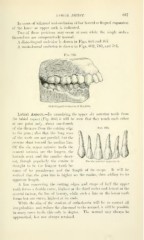Page 689 - My FlipBook
P. 689
LABIAL ASPECT. 687
In cases of bilateral mal-occlusion either buccal or lingual expansion
of the lower or upper arch is indicated.
Two of these positions may occur at once while the single arches
themselves are comparatively normal.
A disto-lingual occlusion is shown in Figs. 603 and 807.
A mesio-buccal occlusion is shown in Figs. 602, 780, and 781.
Fig. 603.
Disto-lingual occlusion of the jaws.
Labial Aspect.—In examining the upper six anterior teeth from
the labial aspect (Fig. 604) it will be seen that they touch each othei-
at one point only, about one-fourth
of the distance from the cutting edge Fig. 604.
to the gum ; also that the long axes
of the teeth are not parallel, ])ut the
crowns slant toward the median line.
Of the six upper anterior teeth the
central incisors are the longest, the
laterals next, and the canines short-
est, though popularly the canine is The six auteriur upper teeth.
thought to be the lono-est ttwth be-
cause of its prominence and the length of its cusps. It will be
noticed that the gum line is higher on the canine, thus addi ug to its
apparent length.
A line connecting the cutting edges and cusps of half the upper
teeth forms a double curve, highest at the third molar and lowest at the
central incisor, the line of beauty, while such a line on the lower teeth
forms but one curve, highest at its ends.
While the aim of the student of orthodontia will be to correct all
irregularities and reduce the abnormal to the normal, it will be possible
in many cases to do this only in degree. The normal may always be
approached, but not always attained.


